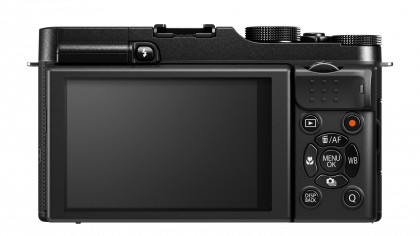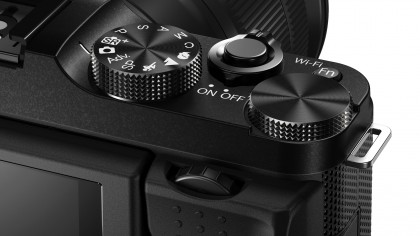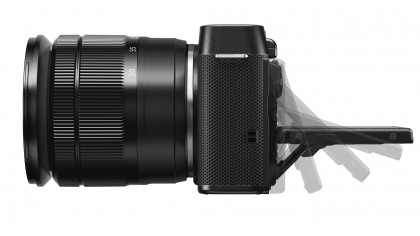Why you can trust TechRadar
Aside from its name badge and the fact that it's available in black, red or blue, the Fuji X-A1 looks exactly like the Fuji X-M1.
These two cameras are considerably smaller than the Fuji X-Pro 1 and Fuji X-E1, but they have the same high quality feel.

A small thumb-rest on the back of the camera and the shallow grip on the front ensure that the X-A1 feels comfortable and relatively secure in your hand, although a little rubber on the thumb-rest wouldn't go amiss.
Unlike the X-Pro1 and X-E1, but like the X-M1, the X-A1 has a dial on the top-plate that is used to select the exposure mode. This provides the usual options of program, shutter priority, aperture priority and manual, along with a fully automatic option and a selection of scene modes. The Advanced Filter modes are also accessed via this dial.
In manual mode a second dial on the top-plate, within easy reach of the right thumb, is used for adjusting shutter speed, while a small dial just above the thumb-rest is used to set aperture. In aperture or shutter priority mode the larger top-plate dial is used to set exposure compensation.

As on the X-M1, there are no controls to the left of X-A1's LCD screen to make the camera easier to use one-handed. In addition to the two dials previously mentioned, the power-switch and the shutter release, there's a Function (Fn) button on then top-plate that can be used to access one of 15 features. We found it useful for accessing the sensitivity settings quickly, as this is something that needs to be changed quite frequently.
In the bottom right corner of the back of the camera is the Q button which gives access to the Quick menu. This shows up to 16 features which may be adjusted by navigating to any of them before using the small dial above the thumb-rest. It's a very quick and easy system to use.
We found the controls to be generally well positioned, but the video button just beneath the thumb-rest was pressed accidentally on a couple of occasions during this test and we shot a couple of seconds of unwanted movie footage.
We also found that the exposure dial on the top-plate was prone to being knocked out of position, and in aperture or shutter priority mode this adjusts the exposure compensation. As there are no markings on the dial it's important to check the on-screen exposure display before taking the shot. However, if you prefer to shoot without the on-screen information display it will go unnoticed.
When shooting indoors or in low-light the three-inch 920,000-dot LCD screen provides a nice clear view with plenty of detail. Although it's not excessively troubled by reflections in bright conditions, as with most cameras they are still an issue in some situations. It's not a major problem, but some users may prefer to opt for X-E1 or X-Pro1 to have the benefit of a viewfinder.

While the tilting bracket for the LCD screen is a bonus when shooting landscape format images from low-level, or above head-height, it's no help when shooting portrait format images.
Several manufacturers are supplementing button and dial controls with a touchscreen these days, but Fuji has yet to do this with its X series. This is a shame, as a touchscreen makes it quicker to change some settings, and is especially useful for setting the AF point.
